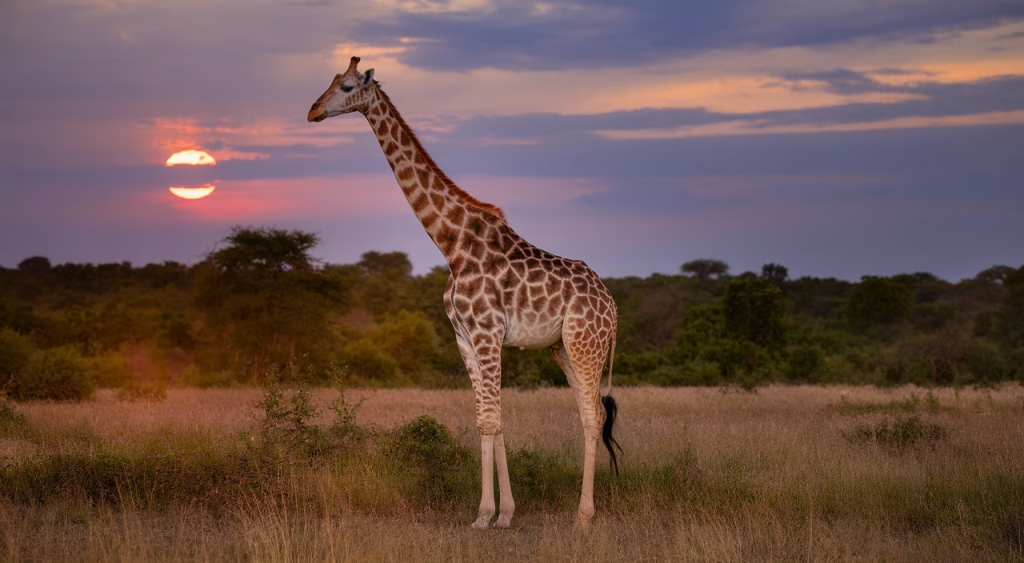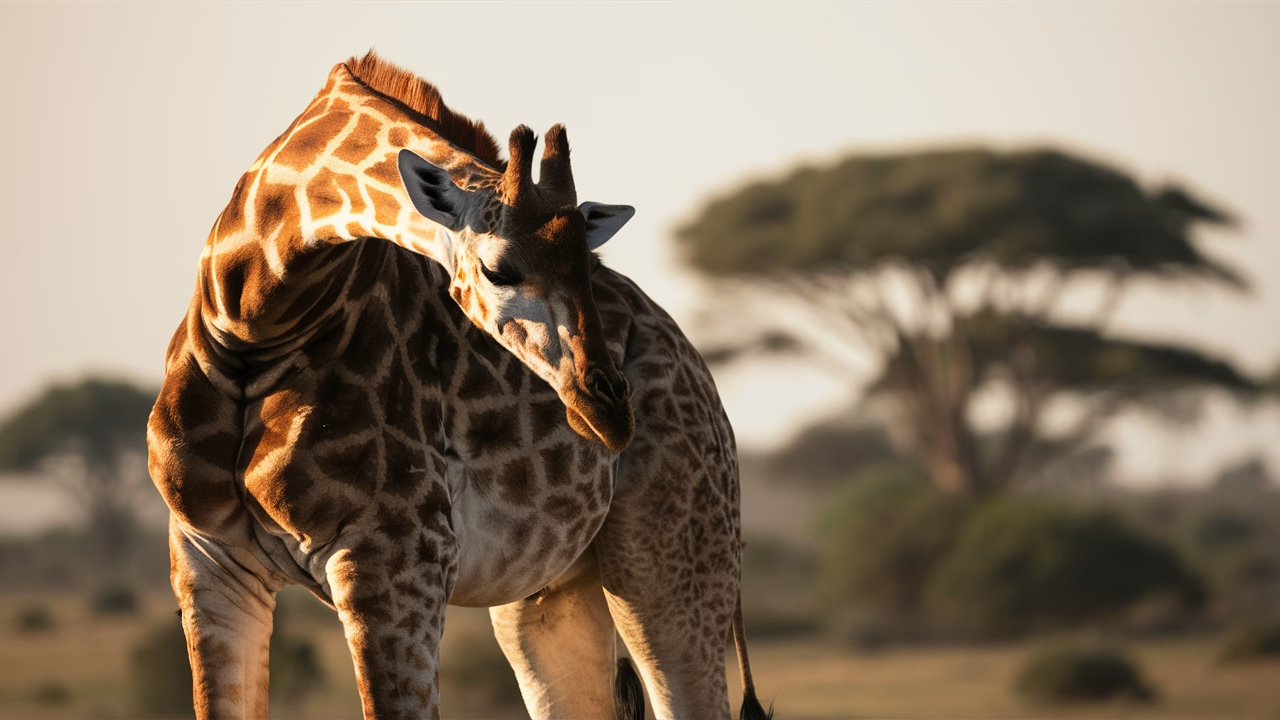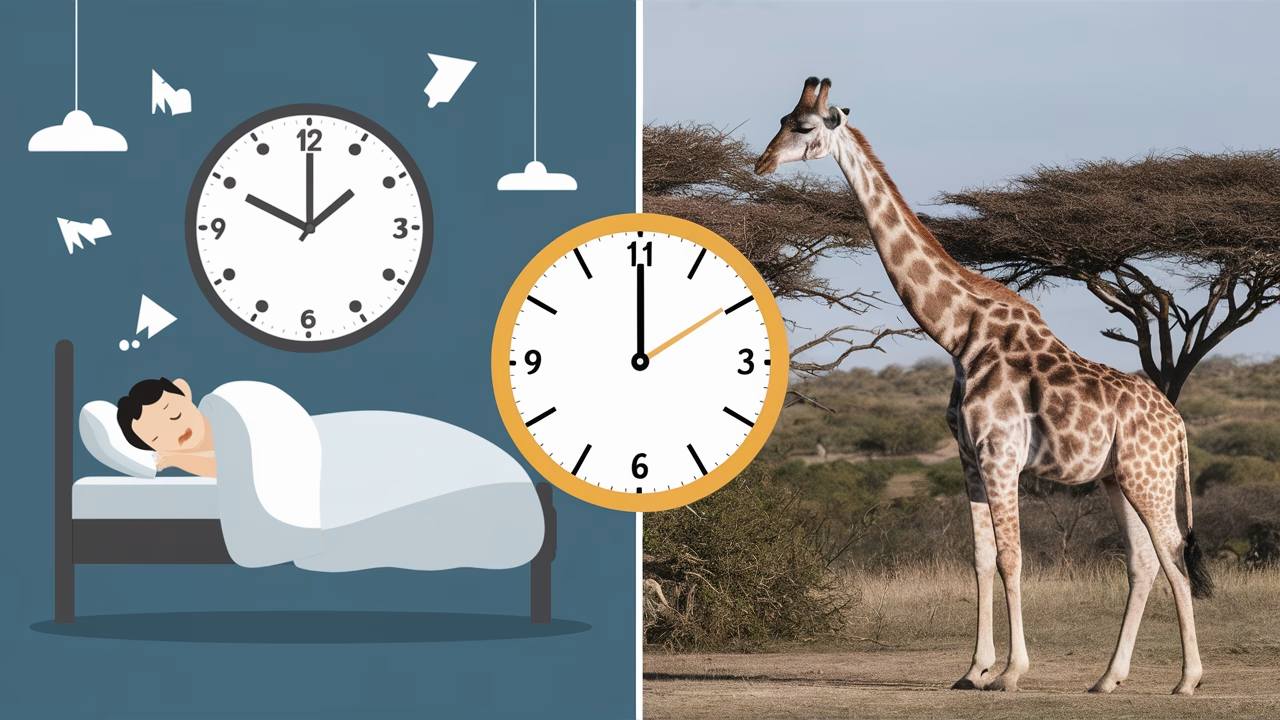Ever wondered how giraffes thrive on just a few hours of sleep?
While you’re reaching for your third cup of coffee after a restless night, giraffes are out there living large—literally—on just 4.6 hours of sleep per day. How? Thanks to highly strategic short naps spaced throughout their day and night. And here’s the wildest part: they don’t even lie down most of the time. So, what can we, groggy humans with white noise apps and blackout curtains, learn from these towering masters of strategic napping? Turns out, plenty.
- Giraffes only sleep around 4.6 hours a day, often in ultra-short naps of just a few minutes each.
- Their giraffe sleeping habits are highly strategic — staying alert for predators means learning how to nap lightly and frequently.
- Baby giraffes (calves) sleep more deeply and in unusual positions — sometimes resembling yoga poses, and more relatable than you’d think.
- Giraffes experience REM sleep in giraffes like humans, but only get around 5 minutes of it per day — showing how little but high-quality rest can still be functional.
- We can learn from these animal sleep comparison insights by embracing strategic napping, especially for those with fragmented nighttime sleep or erratic schedules.
The Giraffe’s Sleep Patterns: Masters of Strategic Napping
The Art of Short, Alert Naps
Unlike humans, giraffes rarely settle in for a long slumber. Their giraffe sleeping habits involve brief bursts—often just 5 minutes at a time, adding up to a total of 4 to 5 hours across an entire 24-hour cycle. This isn’t just a quirky trait; it’s a critical survival strategy. Being so tall and gangly makes relaxing on the ground risky. So, they stand or fold their legs beneath them for micro-sleeps when they feel safe enough.
Think of this like power-saving mode on your phone—conserving just enough energy to stay functional but responsive. Biologically, giraffes have optimized their sleep for safety and simplicity. Their short naps are light and allow them to awaken quickly if danger approaches, making strategic napping an evolutionary advantage.
Unique Sleeping Positions
When they do feel secure enough to lie down, giraffes may fold their legs, twist their long necks back, and rest their heads on their hips—like yoga meets origami. It looks awkward but serves a purpose. It stabilizes their necks and keeps them balanced for a quick escape if needed. If you’ve ever tried sneaking short naps in an office chair or nodded off on a couch too small for your body, you know exactly how functional awkward napping can be.
Why Giraffes Nap Strategically
Why would an animal practice strategic napping like it’s always on alert? Simple: survival. In the wild, being caught lying down could mean being caught off-guard. Lions, hyenas, and leopards are always looking for an easy target. The less time a giraffe spends prone, the less preferable a target they become. These carefully spaced short naps allow for consistent rest without compromising safety or energy levels.
This represents strategic napping at its finest. And while we humans aren’t dodging predators daily, we’re navigating demanding schedules, high stress, and sleep-disrupting technologies. The benefits of napping offer a smart, practical way to counteract modern sleep debt—without needing to crash for hours mid-day.
Sleep Habits of Giraffe Calves
If you thought adult giraffe sleeping habits were peculiar, wait until you meet their calves. Baby giraffes sleep more than adults—roughly 6 hours per day—and they tend to lie down to do it. But since they still need to be alert, they often curl their necks back and rest their heads on their hindquarters. It’s restful, functional, and barely believable unless you see it yourself.
Interestingly, much of their sleep happens during nighttime when the herd is most protective. Calves are especially vulnerable to predators, so sleeping in a tight group provides extra assurance. That shared sense of security improves their sleep quality. The takeaway from this animal sleep comparison? The environment we sleep in—who we’re around, how safe we feel—greatly impacts how well we rest, no matter the species.
Comparing Giraffe and Human Sleep
| Feature | Giraffe | Human |
|---|---|---|
| Average Total Sleep | 4.6 hours/day | 7-9 hours/night |
| Sleep Distribution | Scattered short naps | One primary sleep period |
| REM Sleep | ~5 minutes/day | 90-120 minutes/night |
| Position While Sleeping | Standing or kneeling | Lying down |
| Vulnerability Impact | High (predator risk) | Low (controlled environments) |
From this animal sleep comparison, it’s clear: humans and giraffes don’t sleep the same way, nor should we. But there’s inspiration in how giraffes adapt based on circumstance—including their ability to find rest in small, repeatable moments. For people with insomnia, shift work, or new parenting duties, understanding the benefits of napping like giraffes is invaluable wisdom.
How Ants Farm Fungi Underground: The Secret World of Trachymyrmex Ant Agriculture
Lessons Learned from Giraffes
So, what can we glean from the majestic, sleep-minimalist giraffe? As a sleep specialist, I see three core insights about strategic napping worth holding onto:
- Short naps have tremendous value: Even a 10–15 minute power nap can restore attention, minimize fatigue, and recharge mood. Just don’t overdo it—longer naps can disrupt nighttime sleep.
- Strategic napping is a learnable skill: Identify your best nap windows, create a quiet zone, and keep it consistent. Like giraffe sleeping habits show us, timing is everything.
- Your sleep environment matters: Just as safety affects how a calf sleeps, feeling mentally secure (no noise, comfortable space) fosters better rest. The benefits of napping increase dramatically in the right setting.
Here’s my challenge to you: instead of viewing short naps as lazy or indulgent, treat them as micro investments in your productivity. Giraffes aren’t sleeping for comfort—they practice strategic napping as a daily survival strategy. While our dangers are different, the fatigue is real. Let’s embrace short rest as a smart choice rather than a guilty one.
Frequently Asked Questions
- Do giraffes actually sleep standing up?
Yes, most giraffe sleeping habits involve standing. Lying down is rare and often not sustained for long periods due to vulnerability. - How much REM sleep do giraffes get?
Only about five minutes per day of REM sleep in giraffes, despite frequent short naps. Their sleep is efficient rather than deep. - Can humans benefit from short naps like giraffes?
Absolutely. The benefits of napping include power naps of 10–20 minutes that boost focus, alertness, and memory recall without affecting nighttime sleep. - Why don’t giraffes sleep longer at once?
Predator risk is too high. Their giraffe sleeping habits prioritize staying upright to ensure they can escape quickly if danger approaches. - What’s the best way to implement strategic napping?
Block 15–20 minutes in the midafternoon for short naps. Find a quiet, cool spot. Turn off distractions. Don’t nap too close to bedtime. - Is REM sleep important for humans?
Yes. Unlike REM sleep in giraffes, humans need longer sleep to get adequate REM cycles for memory, learning, and emotional regulation. - Why do baby giraffes sleep more?
Because they’re still growing and are safely surrounded by protective adults. Like human infants, they require more sleep for development, showing interesting patterns in this animal sleep comparison.





